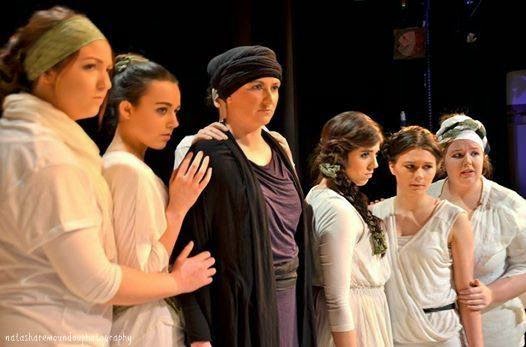Natasha Remoundou-Howley
About Electra
“How could we, too, have found a way to
stay independent in the wonderful
joy of indifference and tolerance, away
from everything, inside of everything, inside of ourselves,—alone, united,
unbound, without comparisons, antagonisms, criticism, without being measured by
the expectations and claims of others.
Yiannis
Ritsos, Orestes (Fourth Dimension), 1966.
“In the century of Orestes and
Electra that is upon us, Oedipus will seem a comedy.”
Heiner Müller.
In Yiannis Ritsos’ poem
“Orestes” written in 1966, a year before the military coup in Athens, Orestes delivers a long dramatic
monologue in which he interrogates the very essence of the autonomy of the
tragic hero. The ferocious saga of the Atreides, the dysfanctional family line
that gave us Agamemnon, The Libation Bearers, The Eumenides, Orestes, and Electra,
finds nowhere a more fertile ground to expose the conflicts that arise between
autonomy and social action than in Sophocles’ narrative, and no other play in
the tragic corpus has divided
academics, artists, and critics than his Electra.
Holding a privileged position on
the modern Greek and international stage, Electra
has been performed since the 18th century in the original, in translation and
in adaptation. Most of these productions have been major artistic events, as
the play’s reception history indicates, highlighting the wide diversity and
complex interconnections between different theatrical traditions, performance
styles and scenic vocabularies. Revived at crucial historical junctures, the
play is preoccupied with time and history, the personal and the collective, conflict,
guilt and revenge, violence and justice, scrutinizing simultaneously
subjectivity, responsibility and the possibility of catharsis from matricide, for the central hero is a vengeful
daughter.
Athens uprising: Greek students leading the resistance to the Colonels Junta in 1973 in Athens.
The pervasiveness of the 20th
Freudian century’s influence with its wars, revolutions, its historical traumas
and apprehensions but also, before that, the performance reception of Electra from the Neoclassical era to the
New Millennium, galvanized very conflicting engagements with the tragic
heroine: from Ben Johnson’s (1604), Crébillon’s (1708), Brumoy’s (1730),
Voltaire’s (1750), Alfieri’s
(1783), Schlegel’s (1803), Jeanin’s (1821), Soume’s (1822), and Bayley’s (1825)
idealized and idolized statuesque Grecian daughter as a figure of resistance
against the oppressor to the catalytic impact of the Hofmannsthal/Reindhardt
hysteric and ecstatic Elektra (1903)
that informs all subsequent productions of the play, the list counts a new wave
of figurations of Electra.
Ben Johnson employed the myth of Electra in an essay he wrote to celebrate Jacob A's ascension to monarchic power in 1604.
Crébillon's Electra in 1708 refigured the heroine as a passionate but tamed advocate of the duty towards to family that supresses her erotic feelings for Aegisthus' son Itis.
In his 1730 treatise Le Théâtre des Grecs, Pierre Brumoy, radically altered the scene of
the agon between Clytaemnestra and Electra as he considered it too brutal.
The famous French actress Mme.Clairon playing Electra holding the ashes of her brother Orestes in Voltaire's Orestes (1750)
The English actress Mary Ann Yates impersonating Electra in 1977.
The theoritician of German Romanticism A.W.Schlegel dealt Electra head on, transforming Sophocles' tragedy of horror into a parable of the exemplary suffering hero par' excellence: unlike the French classicists of the Neoclassical era, he did not work on an adaptation but chose to directly translate the source text. Inspired by the noble suffering of the tragic subject, Schlegel's 1803 Electra became the symbol of his "eine edle Einfalt und eine stille Grosse" (noble simplicity and moral greatness).
The Electras that haunt most of the
post-1903 productions of the Sophoclean play, owe a great deal to the
Hofmannsthal/Reindhardt Elektra and
her pathological obsession, the vain energy, the fierce, uncompromising mania
of the female mourner and avenger. Physically torn and mentally shattered,
steeped into a perseverant frenetic hatred rather than a royal desperation and
sadness, dark, ugly, exhausted, spectacularly sick, Electra whose name means “without a bed” electrifies the modern stage
like no other.
Hugo von Hofmannsthal's production of Elektra directed by Karl Reindhardt (Kleines Theater, Berlin, 1903) brought about a revolution in the way Electra was represented on stage and in the text.
A hysterical diva: the 1903 Hofmannsthal/Reindhardt Elektra became a libretto for the opera by Richard Strauss in 1909. In the photo, Annie Crowl, Dresden Opera, 1909.
The dialogue that opens up between the myth of the Atreides and modernity
is equally impressive. The fin de siècle
may well be termed “the century of Electra,” overshadowing even Oedipus in its
darkness and despair. The Sophoclean Electra
might not have enjoyed the rich stage and philosophical career that Antigone and Oedipus have, however, the 20th Oedipal century saw the
resurgence of an interest in Electra, the female psyche, as what Bernard Knox
calls the most “self-analytical” of tragic heroes, and the Sophoclean play as
an astute study and intense examination into the “psychopathology of revenge”
(E.Hall). Works like the ones by O’Neill (1929-31), Dylan Thomas
(1933), Edward and Christine Longford (1935), MacNeice (1936), Girodoux (1937),
Eliot (1939), Sartre (1943), Yioursenar (1944), Howptman (1947), Streller
(1951), Sylvia Plath (1957), Vitez (1966), Ronconi (1972), Tom Murphy (1975), Peter
Stein (1980), Peter Hall, Tadassi Suzuki, Tom Paulin (1990), the Warner/Shaw
production (1992), Sarah Kane, Seamus Heaney (1996), Marinna Carr (2002), Simon
Doyle (2010) and Frank McGuinness (1997), open up new perspectives on the idea
of the tragic experience. Looking
at the sinuous aesthetic and ideological trajectory of productions of Electra since the 20th
century, one can only anticipate in the century of Electra and Orestes not just
new figures and texts, but new figurations, fissures, gaps, lacunae that Electra’s tragedy unveils: fissures of narrative, of the tragic, fissures of the psyche.
Eirini Papa as Euripides' Electra is Michalis Cacoyiannis' 1962 film.
Zoe Wanamaker in Frank McGuinness's Electra, 1997.
Stefania Goulioti playing Sophocles' Electra, directed by Peter Stein.
Epidaurus, Greece, 2007.
Epidaurus, Greece, 2007.






_-_Tome_3.djvu.jpg)









No comments:
Post a Comment